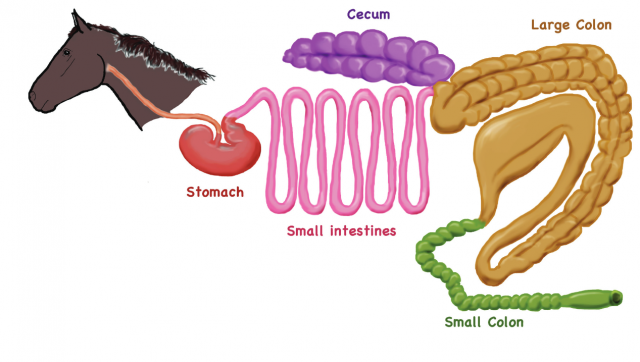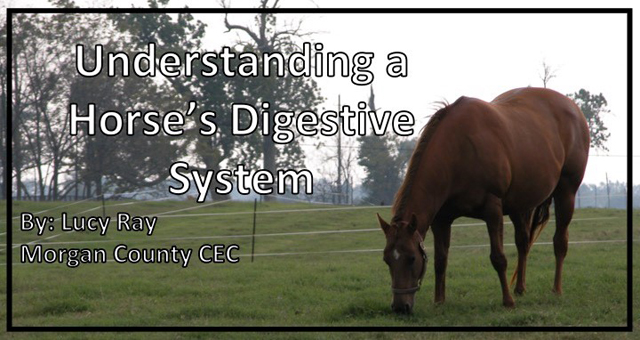Lucy Ray, Morgan County UGA Extension
The horse has one of the most complex, and arguably, the most frustrating, digestive systems of any grazing livestock species that owners/producers deal with. When one thinks of feeding horses, frightening scenarios like colic and founder can come to mind. While certain parts of the horse’s digestive system can cause them to be more difficult to feed than cattle, other features can make horses easier to maintain than ruminants.
Horses are classified as non-ruminant herbivores. This means that they have the capacity to break down the cellulose and hemi-cellulose components in forages without the four-chambered stomach that cattle have. Horses breakdown these structural components of roughages via a microbial population in a modified part of the digestive system called the cecum. The cecum is located behind the stomach in the digestive system. It is for this reason that horses are also called hind-gut fermenters. Cattle, sheep, and other ruminants, have food deposited into the rumen first, where it goes through a microbial digestive process before moving onto other compartments such as the true stomach. A diagram of the equine digestive system is shown below.

Illustration of the various components that encompasses the equine gastrointestinal tract. Source: UGA Extension Equine Colic
Before delving too deeply into the differences in ruminant and non-ruminant herbivores, perhaps we should give an overview of how a horse grazes and what happens to the forage once it enters the digestive system. A typical 1000 lb horse will graze approximately 12-18 hours/day. Horses are spot grazers, they have specialized mouths to select and eat the tops of the plants that they like. They rarely graze in “rough areas” or areas where they defecate. Because of the selective behavior, horses have a reputation as rough and detrimental on pastures and forage species. This reputation is not entirely undeserved.
Horse chewing movement is both lateral and vertical. From the mouth, the forage travels down the esophagus. The esophagus has one-way peristaltic action which means that horses cannot regurgitate their food and therefore can’t “chew their cud.” They also cannot burp or pass gas through their esophagus.
From the esophagus, forage travels to the stomach. A horse’s stomach is approximately 4 gallons and is the smallest in relation to its size of any other livestock species. The stomach secretes hydrochloric acid (HCL) and specific enzymes. Production of HCL is continuous and can contribute to ulcers in horses who are not fed properly. Remember, horses are designed to graze 12-18 hours a day! In the small intestine, some nutrients are absorbed and bile is secreted directly from the liver into the first part of the small intestine. The continuous production of HCL and the way that bile is secreted into the small intestine make it necessary for horses to consume small meals several times a day.
The horse’s large intestine accounts for 60% of the total volume of the digestive tract. The cecum contains active bacteria similar to the microbes of the rumen. Bacterial breakdown of cellulose and other carbohydrates result in the production of volatile fatty acids (VFAs). VFAs are a source of energy similar to glucose and other sugars. The small colon is the primary site of water absorption and the rectum is where manure is expelled.Several of these attributes add up to making horses susceptible to digestive upsets. For example, the inability to regurgitate food or gas, means that everything must be expelled through the rear of the animal. This can result in gas colic, or impaction colic as sometimes the material has a LONG way to travel before exiting the animal. Moldy hay is more likely to cause issues in horses. Since the equine digestive system doesn’t have a lot of muscular contractions, adequate water is essential to keep things moving through the tract. Again, this can result in impactions and digestive issues if there is not enough fluid available.
However, the speed at which food moves through the digestive tract, makes non-ruminant herbivores more likely to be “easy keepers” than most ruminants. They can move a larger volume of feed through their systems and extract the nutrients more rapidly. In addition, there is some research to suggest that horses handle high nitrates in forages better than ruminants due to the physical makeup of their digestive system.
There are limitations and benefits to the equine digestive system. As long as one keeps in mind the anatomy of the horse and how they were designed to eat, the pitfalls long associated with feeding horses can be minimized.
For more information on this subject, use the following publication links:
- Digestive System of the Horse and Feeding Management (Arkansas Extension)
- Equine Colic (Georgia Extension)
- Northwest Florida Beef Cattle Conference & Trade Show – February 11 - December 19, 2025
- Friday Feature:The Sears Catalog –How Rural America Shopped before the Internet - December 19, 2025
- November 2025 Weather Summary & Winter Outlook - December 5, 2025

